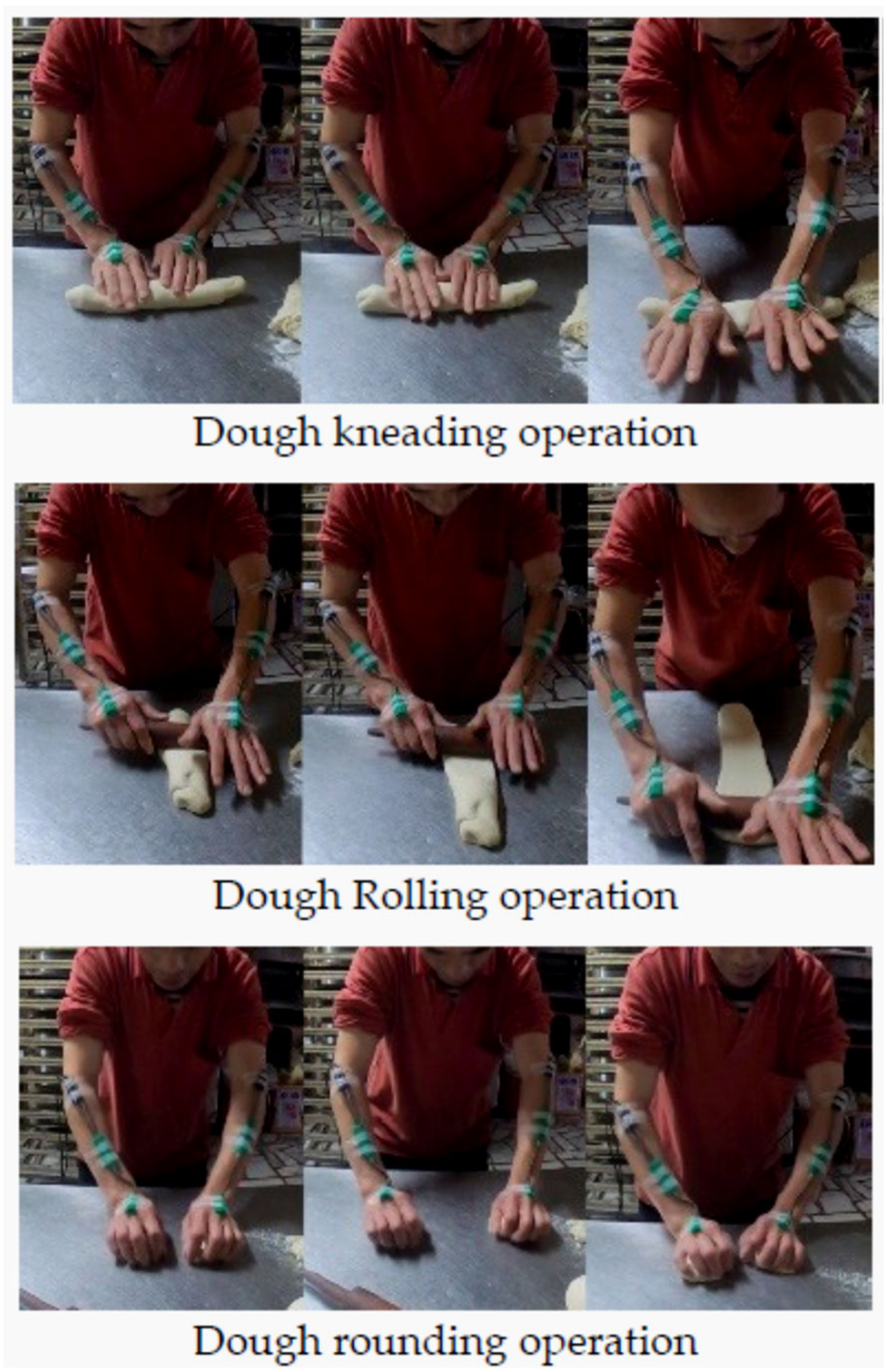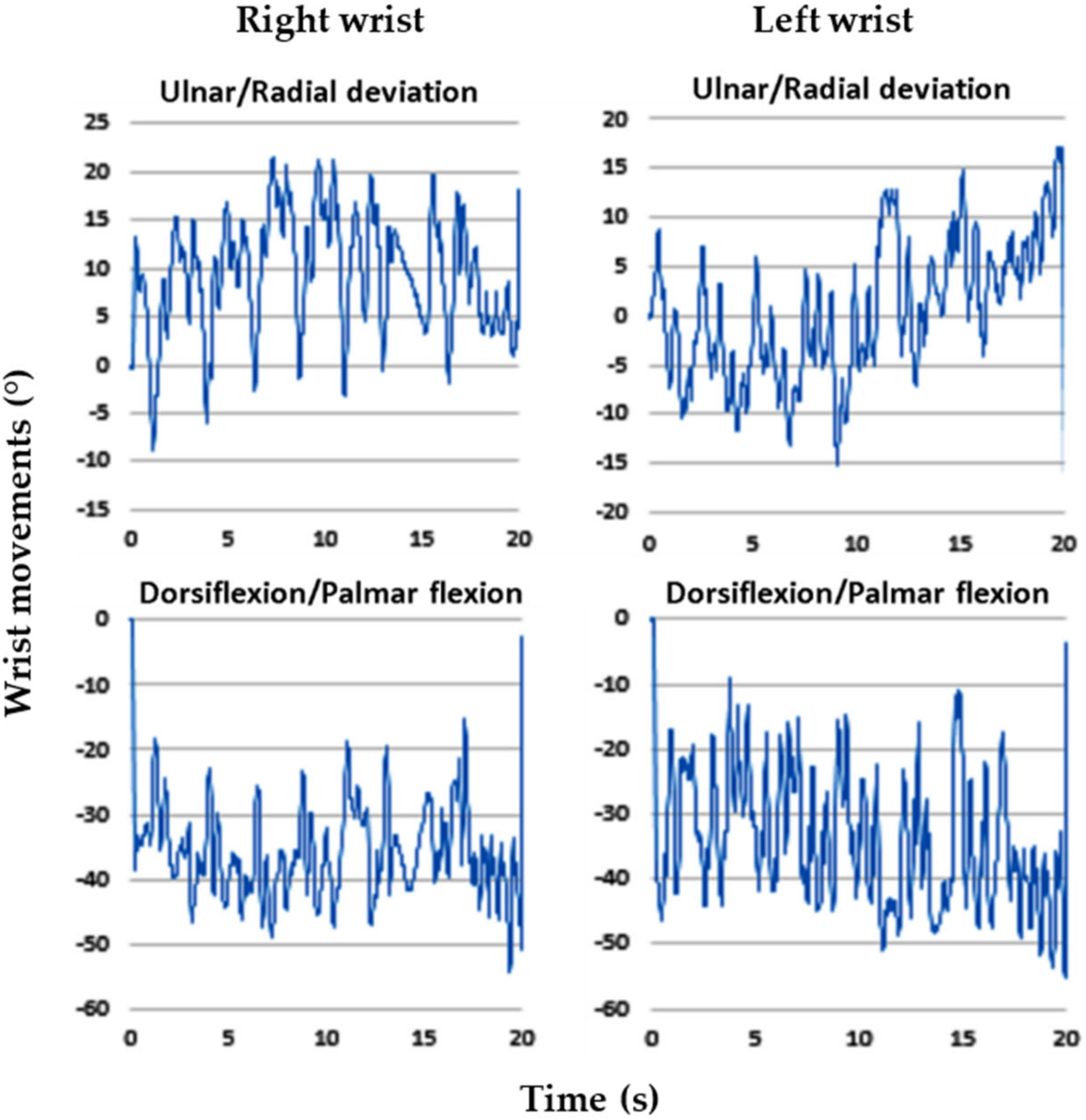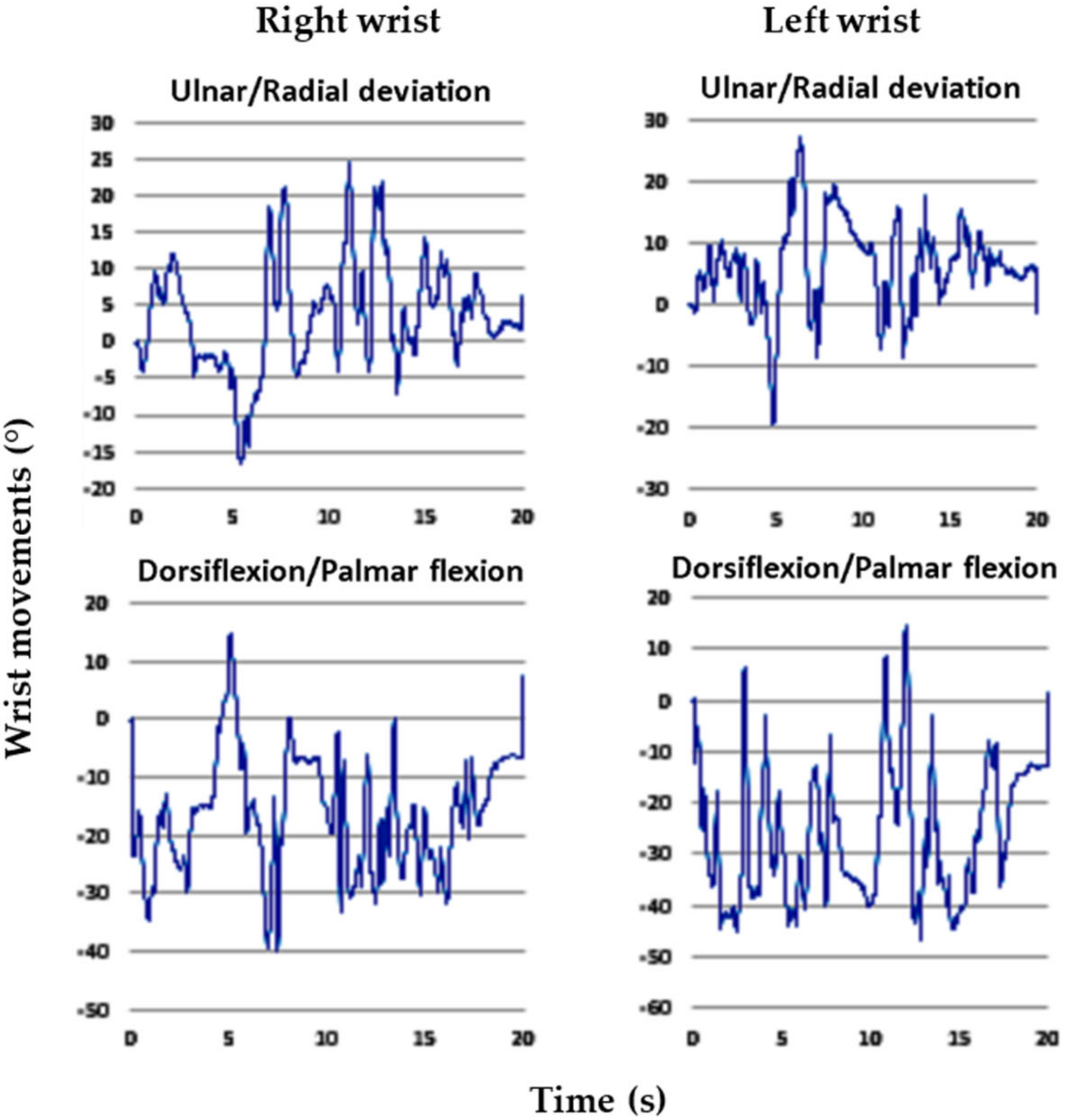Musculoskeletal Disorders Symptoms among Taiwanese Bakery Workers
Abstract
:1. Introduction
2. Materials and Methods
2.1. NMQ
2.2. Measurement of Wrist Movement
2.3. Statistical Analysis
3. Results
3.1. Demographics
3.2. Work-Related Characteristics
3.3. NMQ Results
3.4. Wrist Movements
4. Discussion
5. Conclusions
Author Contributions
Funding
Acknowledgments
Conflicts of Interest
References
- Cohen, A.L.; Gjessing, C.C.; Fine, L.J.; Bernard, B.P.; McGlothin, J.D. Elements of Ergonomics Programs, a Primer Based on Workplace Evaluations of Musculoskeletal Disorders; National Institute for Occupational Safety and Health: Cincinnati, OH, USA, 1997. [Google Scholar]
- Melhorn, J.M. Cumulative trauma disorders and repetitive strain injuries the future. Clin. Orthop. Relat. Res. 1998, 351, 107–126. [Google Scholar] [CrossRef]
- Forcier, L.; Lapointe, C.; Lortie, M.; Buckle, P.; Kuorinka, I.; Lemaire, J.; Beaugrand, S. Supermarket workers: Their work and their health, particularly their self-reported musculoskeletal problems and compensable injuries. Work 2008, 30, 493–510. [Google Scholar]
- Denis, D.; St-Vincent, M.; Imbeau, D.; Jette, C.; Nastasia, I. Intervention practices in musculoskeletal disorder prevention: A critical literature review. Appl. Ergon. 2008, 39, 1–14. [Google Scholar] [CrossRef] [PubMed]
- da Costa, B.R.; Vieira, E.R. Risk factors for work-related musculoskeletal disorders: A systematic review of recent longitudinal studies. Am. J. Ind. Med. 2010, 53, 285–323. [Google Scholar] [CrossRef] [PubMed]
- Schmalz, T.; Schändlinger, J.; Schuler, M.; Bornmann, J.; Schirrmeister, B.; Kannenberg, A.; Ernst, M. Biomechanical and Metabolic Effectiveness of an Industrial Exoskeleton for Overhead Work. Int. J. Environ. Res. Public. Health 2019, 16, 4792. [Google Scholar] [CrossRef] [Green Version]
- Otto, A.; Battaïa, O. Reducing physical ergonomic risks at assembly lines by line balancing and job rotation: A survey. Comput. Ind. Eng. 2017, 111, 467–480. [Google Scholar] [CrossRef]
- Harmse, J.L.; Engelbrecht, J.C.; Bekker, J.L. The impact of physical and ergonomic hazards on poultry abattoir processing workers: A review. Int. J. Environ. Res. Pub. Health 2016, 13, 197. [Google Scholar] [CrossRef]
- Abaraogu, U.O.; Odebiyi, D.O.; Olawale, O.A. Association between postures and work-related musculoskeletal discomforts (WRMD) among beverage bottling workers. Work 2016, 54, 113–119. [Google Scholar] [CrossRef]
- Anton, D.; Weeks, D.L. Prevalence of work-related musculoskeletal symptoms among grocery workers. Int. J. Ind. Ergon. 2016, 54, 139–145. [Google Scholar] [CrossRef]
- Chiang, C.L.; Liao, C.Y.; Kuo, H.W. Postures of upper extremity correlated with carpal tunnel syndrome (CTS). Int. J. Occup. Med. Environ. Health 2017, 30, 281–290. [Google Scholar] [CrossRef] [Green Version]
- Boskabady, M.H.; Taheri, E.; Ahmadi, S.; Ebrahimi, K.; Soudaneh, M.; Mohammadi, F.; Sabourhasanzadeh, A. Pulmonary function tests and work-related respiratory and allergic symptoms in Iranian bakers. Iran. J. Allergy. Asthma. Immunol. 2009, 8, 107–110. [Google Scholar] [PubMed]
- Meijster, T.; van Duuren-Stuurman, B.; Heederik, D.; Houba, R.; Koningsveld, E.; Warren, N.; Tielemans, E. Cost-benefit analysis in occupational health: A comparison of intervention scenarios for occupational asthma and rhinitis among bakery workers. Occup. Environ. Med. 2011, 68, 739–745. [Google Scholar] [CrossRef] [PubMed] [Green Version]
- Moghaddasi, Y.; Mirmohammadi, S.; Ahmad, A.; Nejad, S.E.; Yazdani, J. Health–risk assessment of workers exposed to flour dust: A cross–Sectional study of random samples of bakeries workers. Atmos. Pollut. Res. 2014, 5, 113–118. [Google Scholar] [CrossRef] [Green Version]
- Bauer, A.; Kelterer, D.; Bartsch, R.; Schlegel, A.; Pearson, J.; Stadeler, M.; Kleesz, P.; Grieshaber, R.; Schiele, R.; Elsner, P.; et al. Prevention of hand dermatitis in bakers’ apprentices: Different efficacy of skin protection measures and UVB hardening. Int. Arch. Occup. Environ. Health 2002, 75, 491–499. [Google Scholar] [CrossRef] [PubMed]
- Habib, R.R.; El-Harakeh, A.; Hojeij, S. Musculoskeletal pain among bakery workers in Lebanon: A national survey. Cogent. Eng. 2019, 6, 1608669. [Google Scholar] [CrossRef]
- Institute of Labor and Occupational Safety and Health (ILOSH). A study of Musculoskeletal Discomfort among Restaurant Trades’ Worker; Project no. IOSH98-H318; ILOSH: New Taipei, Taiwan, 2010. Available online: https://laws.ilosh.gov.tw/ioshcustom/Web/YearlyReserachReports/Detail?id=1257 (accessed on 30 March 2020). (In Chinese)
- Nawrocka, A.; Mynarski, W.; Powerska, A.; Grabara, M.; Groffik, D.; Borek, Z. Health-oriented physical activity in prevention of musculoskeletal disorders among young Polish musicians. Int. J. Occup. Med. Environ. Health 2014, 27, 28–37. [Google Scholar] [CrossRef]
- Takekawa, K.S.; Goncalves, J.S.; Moriguchi, C.S.; Coury, H.J.C.G. Can a self-administered questionnaire identify workers with chronic or recurring low back pain? Ind. Health 2015, 53, 340–345. [Google Scholar] [CrossRef] [Green Version]
- Deakin, J.M.; Stevenson, J.M.; Vail, G.R.; Nelson, J.M. The use of the Nordic Questionnaire in an industrial setting: A case study. Appl. Ergon. 1994, 25, 182–185. [Google Scholar] [CrossRef]
- Lu, J.M.; Twu, L.J.; Wang, M.J.J. Risk assessments of work-related musculoskeletal disorders among the TFT-LCD manufacturing operators. Int. J. Ind. Ergon. 2016, 52, 40–51. [Google Scholar] [CrossRef]
- Chen, Y.L.; Yu, C.Y.; Lin, D.Y. Musculoskeletal disorders caused by gas-cylinder handling tasks: A case study report. Work 2017, 56, 403–407. [Google Scholar] [CrossRef]
- Sain, M.K.; Meena, M. Identifying musculoskeletal issues and associated risk factors among clay brick kiln workers. Ind. Health 2019, 57, 381–391. [Google Scholar] [CrossRef] [PubMed] [Green Version]
- Stetson, D.S.; Keyserling, W.M.; Silverstein, B.A.; Leonard, J.A. Observational analysis of the hand and wrist: A pilot study. Appl. Occup. Environ. Hyg. 1991, 6, 927–935. [Google Scholar] [CrossRef]
- Institute of Labor and Occupational Safety and Health (ILOSH). Survey of Perceptions of Safety and Health in the Work Environment in 2016 Taiwan; Project no. ILOSH105-M309; ILOSH: New Taipei, Taiwan, 2017; Available online: https://ILOSH105-A309-FINAL%E5%AE%8C%E6%95%B4%E7%89%88.pdf (accessed on 30 March 2020). (In Chinese)
- Genebra, C.V.D.S.; Maciel, N.M.; Bento, T.P.F.; Simeão, S.F.A.P.; De Vitta, A. Prevalence and factors associated with neck pain: A population-based study. Braz. J. Phys. Ther. 2017, 21, 274–280. [Google Scholar] [CrossRef] [PubMed]
- Ryu, J.; Cocney, W.; Askew, L.; An, K.; Chao, E. Functional ranges of motion of the wrist joint. J. Hand Surg. 1991, 16, 409–419. [Google Scholar] [CrossRef]
- Ojima, H.; Miyake, S.; Kumashiro, M. Range of dynamic motion of the wrist in healthy young and middle-aged men. Ergonomics 1992, 35, 1467–1477. [Google Scholar] [CrossRef] [PubMed]
- Boone, D.; Azen, S. Normal range of motion in joint male subjects. J. Bone Joint Surg. 1979, 61, 756–759. [Google Scholar] [CrossRef] [PubMed]
- Lin, M.; Radwin, R. A single metric for quantifying biomechanical stress in repetitive motions and exertions. Ergonomics 1997, 40, 543–558. [Google Scholar] [CrossRef] [PubMed]
- Niebel, B.W.; Freivalds, A. Niebel’s Methods, Standards, and Work Design; McGraw-Hill: New York, NY, USA, 2013. [Google Scholar]







| Body Parts | Entire Working Population (%) | Hospitality and Food Industry (%) | Recreation Industry (%) | Other Service Industries (%) | This Study (%) * |
|---|---|---|---|---|---|
| Neck | 32.3 | 28.7 | 30.1 | 32.9 | 32.5 |
| Shoulders | 41.3 | 42.0 | 38.6 | 40.9 | 45.8/50.6 |
| Upper back | 22.3 | 23.4 | 20.8 | 23.8 | 32.5 |
| Elbows | 20.5 | 27.9 | 17.0 | 24.3 | 19.3/28.9 |
| Lower back/waist | 31.0 | 35.0 | 29.2 | 30.7 | 48.2 |
| Hands/wrists | 26.5 | 36.4 | 28.1 | 30.5 | 51.8/66.3 |
| Buttocks/thighs | 11.8 | 13.5 | 14.4 | 12.7 | 13.3/12.0 |
| Knees | 16.9 | 19.2 | 15.2 | 20.4 | 20.5/21.7 |
| Legs/ankles | 14.6 | 17.8 | 15.3 | 15.5 | 15.7/16.9 |
| Body Parts (Prevalence %) | Risk Factors | Category | n | OR | 95% CI |
|---|---|---|---|---|---|
| Right hand/wrist (66.3%) | Rolling pin use | Seldom | 20 | 1.00 | - |
| Occasionally and more | 61 | 4.30 * | 1.36–13.61 | ||
| Dough kneading | Seldom | 32 | 1.00 | - | |
| Occasionally and more | 49 | 4.23 * | 1.40–12.81 | ||
| Stature | <170 cm | 35 | 1.00 | - | |
| ≥170 cm | 46 | 3.73 * | 1.25–11.19 | ||
| Left hand/wrist (51.8%) | Rolling pin use | Seldom | 20 | 1.00 | - |
| Occasionally and more | 61 | 4.57 * | 1.33–15.73 | ||
| Dough kneading | Seldom | 32 | 1.00 | - | |
| Occasionally and more | 49 | 6.13 *** | 2.05–18.32 | ||
| Stature | <170 cm | 35 | 1.00 | - | |
| ≥170 cm | 46 | 6.82 ** | 2.16–21.52 | ||
| Right shoulder (50.6%) | Rolling pin use | Seldom | 20 | 1.00 | - |
| Occasionally and more | 61 | 5.29 ** | 1.76–15.89 | ||
| Lifting objects | Seldom | 33 | 1.00 | - | |
| Occasionally and more | 48 | 14.50 ** | 3.19–29.83 | ||
| Number of times pastries are removed out of the oven per day | <20 trays | 38 | 1.00 | - | |
| ≥20 trays | 43 | 9.04 *** | 3.31–26.91 | ||
| Working hours per day | <9 h | 40 | 1.00 | - | |
| ≥9 h | 41 | 5.08 *** | 1.83–14.70 | ||
| Job tenure | <10 y | 56 | 1.00 | - | |
| ≥10 y | 25 | 7.56 *** | 2.20–25.92 | ||
| Age | <30 y | 49 | 1.00 | - | |
| ≥30 y | 32 | 5.25 *** | 1.86–14.80 | ||
| Lower back /waist (48.2%) | Rolling pin use | Seldom | 20 | 1.00 | - |
| Occasionally and more | 61 | 2.54 * | 0.98–6.54 | ||
| Lifting objects | Seldom | 33 | 1.00 | - | |
| Occasionally and more | 48 | 4.69 *** | 1.81–12.14 | ||
| Number of times pastries are removed out of the oven per day | <20 trays | 38 | 1.00 | - | |
| ≥20 trays | 43 | 4.55 *** | 1.77–11.66 | ||
| Age | <30 y | 49 | 1.00 | - | |
| ≥30 y | 32 | 4.04 * | 1.30–12.53 | ||
| Left shoulder (45.8%) | Rolling pin use | Seldom | 20 | 1.00 | - |
| Occasionally and more | 61 | 3.88 ** | 1.37–10.98 | ||
| Lifting objects | Seldom | 33 | 1.00 | - | |
| Occasionally and more | 48 | 9.75 *** | 3.19–29.83 | ||
| Number of times pastries are removed out of the oven per day | <20 trays | 38 | 1.00 | - | |
| ≥20 trays | 43 | 5.54 ** | 1.99–15.42 | ||
| Working hours per day | <9 h | 40 | 1.00 | - | |
| ≥9 h | 41 | 4.24 * | 1.56–11.52 | ||
| Job tenure | <10 y | 56 | 1.00 | - | |
| ≥10 y | 25 | 4.85 ** | 1.60–14.77 | ||
| Age | <30 y | 49 | 1.00 | - | |
| ≥30 y | 32 | 4.24 ** | 1.55–11.60 |
© 2020 by the authors. Licensee MDPI, Basel, Switzerland. This article is an open access article distributed under the terms and conditions of the Creative Commons Attribution (CC BY) license (http://creativecommons.org/licenses/by/4.0/).
Share and Cite
Chen, Y.-L.; Zhong, Y.-T.; Liou, B.-N.; Yang, C.-C. Musculoskeletal Disorders Symptoms among Taiwanese Bakery Workers. Int. J. Environ. Res. Public Health 2020, 17, 2960. https://0-doi-org.brum.beds.ac.uk/10.3390/ijerph17082960
Chen Y-L, Zhong Y-T, Liou B-N, Yang C-C. Musculoskeletal Disorders Symptoms among Taiwanese Bakery Workers. International Journal of Environmental Research and Public Health. 2020; 17(8):2960. https://0-doi-org.brum.beds.ac.uk/10.3390/ijerph17082960
Chicago/Turabian StyleChen, Yi-Lang, Yan-Ting Zhong, Bang-Nan Liou, and Chih-Chuan Yang. 2020. "Musculoskeletal Disorders Symptoms among Taiwanese Bakery Workers" International Journal of Environmental Research and Public Health 17, no. 8: 2960. https://0-doi-org.brum.beds.ac.uk/10.3390/ijerph17082960





